How to Meet the Green Deal Objectives—Is It Possible to Obtain 100% RES at the Regional Level in the EU?
Abstract
:1. Introduction
- Fair;
- participatory, local, bottom-up;
- focused on modernization and innovation;
- stimulating economic development, efficiency, and competitiveness.
2. Methodology—GIS in RES Research
3. The Description of the Greater Poland Voivodeship
4. Wind Energy Potential in the Greater Poland Voivodeship
5. Solar Energy Potential in the Greater Poland Voivodeship
6. The Biomass Energy Potential in the Greater Poland Voivodeship
6.1. The Technical Potential of Waste Wood
6.2. The Technical Potential of Straw and Hay from Unused Meadows, Pastures, and Energy Crops
6.3. The Technical Potential of Agricultural Biogas
6.4. The Technical Potential of Biogas from Municipal Waste and Sewage Treatment Plants
6.5. The Total Technical Potential of Bioenergy in the Voivodeship
7. The Water Energy Potential in the Greater Poland Voivodeship
8. The Geothermal Energy Potential in the Greater Poland Voivodeship
9. Total Technical Potential of the Renewable Energy in the Greater Poland Voivodeship
10. Discussion and Summary
Author Contributions
Funding
Data Availability Statement
Conflicts of Interest
References
- Hussain, H.I.; Szczepańska-Woszczyna, K.; Kamarudin, F.; Anwar, N.A.M.; Saudi, M.H.M. Unboxing the black box on the dimensions of social globalisation and the efficiency of microfinance institutions in Asia. Oeconomia Copernic. 2021, 12, 557–592. [Google Scholar] [CrossRef]
- Rees, W.E. Globalization, trade and migration: Undermining sustainability. Ecol. Econom. 2006, 2, 220–225. [Google Scholar] [CrossRef]
- Barłożewski, K.; Trąpczyński, P. Is internationalisation beneficial for novice internationalisers? The performance effects of firm-specific advantages, internationalisation degree and firm size revisited. Oeconomia Copernic. 2021, 12, 53–75. [Google Scholar] [CrossRef]
- Szopik-Depczyńska, K.; Cheba, K.; Bąk, I.; Stajniak, M.; Simboli, A.; Ioppolo, G. The study of relationship in a hierarchical structure of EU sustainable development indicators. Ecol. Indic. 2018, 90, 120–131. [Google Scholar] [CrossRef]
- Skare, M.; Porada-Rochoń, M. Financial and economic development link in transitional economies: A spectral Granger causality analysis 1991–2017. Oeconomia Copernic. 2019, 1, 7–35. [Google Scholar] [CrossRef]
- Sánchez-López, C.; Aceytuno, M.T.; De Paz-Bañez, M.A. Inequality and globalisation: Analysis of European countries. Econ. Sociol. 2019, 4, 84–100. [Google Scholar] [CrossRef] [PubMed]
- Simionescu, M.; Lazányi, K.; Sopková, G.; Dobeš, K.; Balcerzak, A.P. Determinants of economic growth in V4 countries and Romania. J. Comp. 2017, 1, 103–113. [Google Scholar] [CrossRef] [Green Version]
- Zinecker, M.; Doubravský, K.; Balcerzak, A.P.; Pietrzak, M.B.; Dohnal, M. The COVID-19 disease and policy response to mitigate the economic impact in the EU: An exploratory study based on qualitative trend analysis. Technol. Econ. Dev. Econ. 2021, 27, 742–762. [Google Scholar] [CrossRef]
- Wosiek, M. Rural-urban divide in human capital in Poland after 1988. Oeconomia Copernic. 2020, 11, 183–201. [Google Scholar] [CrossRef] [Green Version]
- Szopik-Depczyńska, K.; Kędzierska-Szczepaniak, A.; Szczepaniak, K.; Cheba, K.; Gajda, W.; Ioppolo, G. Innovation in sustainable development: An investigation of the EU context using 2030 agenda indicators. Land Use Policy 2018, 79, 251–262. [Google Scholar] [CrossRef]
- Roszko-Wójtowicz, E.; Grzelak, M.M. Macroeconomic stability and the level of competitiveness in EU member states: A comparative dynamic approach. Oeconomia Copernic. 2020, 11, 657–688. [Google Scholar] [CrossRef]
- Prokop, V.; Kotkova Striteska, M.; Stejskal, J. Fostering Czech firms? innovation performance through efficient cooperation. Oeconomia Copernic. 2021, 12, 671–700. [Google Scholar] [CrossRef]
- Markauskas, M.; Baliute, A. Technological progress spillover effect in Lithuanian manufacturing industry. Equilib. Q. J. Econ. Econ. Policy 2021, 16, 783–806. [Google Scholar] [CrossRef]
- Nowak, P. Cooperation of enterprises in innovative activities on the example of Polish regions. Equilib. Q. J. Econ. Econ. Policy 2021, 16, 839–857. [Google Scholar] [CrossRef]
- Balcerzak, A.P. Quality of institutions in the European Union countries. Application of TOPSIS based on entropy measure for objective weighting. Acta Polytech. Hung. 2020, 1, 101–122. [Google Scholar] [CrossRef]
- Zielenkiewicz, M. Institutional environment in the context of development of sustainable society in the European Union countries. Equilibrium. Quart. J. Econ. Econ. Policy 2014, 9, 21–37. [Google Scholar] [CrossRef]
- Belke, A.; Dreger, C.; Dobnik, F. Energy consumption and economic growth–new insights into the cointegration relationship. Energy Econom. 2010, 33, 782–789. [Google Scholar] [CrossRef] [Green Version]
- Piekut, M. The consumption of renewable energy sources (RES) by the European Union households between 2004 and 2019. Energies 2021, 14, 5560. [Google Scholar] [CrossRef]
- Jankiewicz, M.; Pietrzak, M.B. Assessment of trends in the share of expenditure on services and food in the Visegrad group member states. Int. J. Bus. Soc. 2020, 2, 977–996. [Google Scholar] [CrossRef]
- Zadykowicz, A.; Chmielewski, K.J.; Siemieniako, D. Proactive customer orientation and joint learning capabilities in collaborative machine to machine innovation technology development: The case study of automotive equipment manufacturer. Oeconomia Copernic. 2020, 11, 531–547. [Google Scholar] [CrossRef]
- Wosiek, M. Unemployment and new firm formation: Evidence from Polish industries at the regional level. Equilib. Q. J. Econ. Econ. Policy 2021, 16, 765–782. [Google Scholar] [CrossRef]
- Fragkos, P.; Paroussos, L. Employment creation in EU related to renewables expansion. Appl. Energy 2018, 230, 935–945. [Google Scholar] [CrossRef]
- Gajdos, A.; Arendt, L.; Balcerzak, A.P.; Pietrzak, M.B. Future trends of labour market polarisation in Poland–The perspective of 2025. Transform. Bus. Econ. 2020, 3, 114–135. [Google Scholar]
- Dmytrów, K.; Bieszk-Stolorz, B. Comparison of changes in the labour markets of post-communist countries with other EU member states. Equilib. Q. J. Econ. Econ. Policy 2021, 16, 741–764. [Google Scholar] [CrossRef]
- Pietrzak, M.B.; Balcerzak, A.P.; Gajdos, A.; Arendt, Ł. Entrepreneurial environment at regional level: The case of Polish path towards sustainable socio-economic development. Entrep. Sustain. Issues 2017, 5, 190–203. [Google Scholar] [CrossRef] [Green Version]
- Svabova, L.; Tesarova, E.N.; Durica, M.; Strakova, L. Evaluation of the impacts of the COVID-19 pandemic on the development of the unemployment rate in Slovakia: Counterfactual before-after comparison. Equilib. Q. J. Econ. Econ. Policy 2021, 16, 261–284. [Google Scholar] [CrossRef]
- Markandya, A.; Arto, I.; Eguino, M.G.; Román, M.V. Towards a green energy economy? Tracking the employment effects of low-carbon technologies in the European Union. Appl. Energy 2016, 179, 1342–1350. [Google Scholar] [CrossRef] [Green Version]
- Pao, H.-T.; Fu, H.-C. Renewable energy, non-renewable energy and economic growth in Brazil. Renew. Sustain. Energy Rev. 2013, 25, 381–392. [Google Scholar] [CrossRef]
- Pietrzak, M.B.; Igliński, B.; Kujawski, W.; Iwański, P. Energy transition in Poland–assessment of the renewable energy sector. Energies 2021, 14, 2046. [Google Scholar] [CrossRef]
- Chovancová, J.; Tej, J. Decoupling economic growth from greenhouse gas emissions: The case of the energy sector in V4 countries. Equilib. Q. J. Econom. Econom. Policy. 2020, 15, 235–251. [Google Scholar] [CrossRef]
- Lin, M.-X.; Liou, H.M.; Chou, K.T. National energy transition framework toward SDG7 with legal reforms and policy bundles: The case of Taiwan and its comparison with Japan. Energies 2020, 13, 1387. [Google Scholar] [CrossRef] [Green Version]
- Grosse, T.G. Low carbon economy policy in Poland: An example of the impact of Europeanisation. Q. J. Econom. Econom. Policy. 2011, 1, 9–39. [Google Scholar] [CrossRef]
- 2019 Europe Sustainable Development Report. In Sustainable Development Solutions Network and Institute for European Environmental Policy; Institute for European Environmental Policy: Brussels, Belgium, 2019.
- Musiał, W.; Zioło, M.; Luty, L.; Musiał, K. Energy policy of European Union member states in the context of renewable energy sources development. Energies 2021, 14, 2864. [Google Scholar] [CrossRef]
- Igliński, B.; Skrzatek, M.; Kujawski, W.; Cichosz, M.; Buczkowski, R. SWOT analysis of renewable Energy sector in Mazowieckie Voivodeship: Current progress, prospects and policy implications. Env. Dev. Sustain. 2021, 24, 77–111. [Google Scholar] [CrossRef]
- Overland, I. Energy: The missing link in globalization. Energy Res. Soc. Sci. 2016, 14, 122–130. [Google Scholar] [CrossRef] [Green Version]
- Kochanek, E. Evaluation of energy transition scenarios in Poland. Energies 2021, 14, 6058. [Google Scholar] [CrossRef]
- Kałążny, A.; Morawski, W. Taxation of assets used to generate energy–in the context of the transformation of the Polish Energy sector from coal energy to low-emission Energy. Energies 2021, 14, 4587. [Google Scholar] [CrossRef]
- Carley, S.; Konisky, D.M. The justice and equity implications of the clean energy transition. Nat. Energy 2020, 5, 569–577. [Google Scholar] [CrossRef]
- David, M.; Schönborn, S. Bottom-up energy transition narratives: Linking the global with the local? A comparison of three German renewable Co-Ops. Sustainability 2018, 10, 924. [Google Scholar] [CrossRef] [Green Version]
- Budzianowski, W.M.; Gomes, J.F.P. Perspectives for low-carbon production until 2030: Lessons learned from the comparison of local context in Poland and Portugal. Energy Sources Part B Econ. Plan. Policy 2016, 6, 534–541. [Google Scholar] [CrossRef]
- Igliński, B.; Kujawski, W.; Buczkowski, R.; Cichosz, M. Renewable energy in the Kujawsko-Pomorskie Voivodeship (Poland). Renew. Sustain. Energ. Rev. 2010, 4, 1336–1341. [Google Scholar] [CrossRef]
- Igliński, B.; Buczkowski, R.; Cichosz, M.; Piechota, G.; Kujawski, W.; Plaskacz, M. Renewable energy production in the Zachodniopomorskie Voivodeship (Poland). Renew. Sustain. Energy Rev. 2013, 27, 768–777. [Google Scholar] [CrossRef]
- Igliński, B.; Piechota, G.; Iglińska, A.; Cichosz, M.; Buczkowski, R. The study on the SWOT analysis of renewable energy sector on the example of the Pomorskie Voivodeship (Poland). Clean Technol. Environ. Policy 2015, 1, 45–61. [Google Scholar] [CrossRef]
- Igliński, B.; Buczkowski, R.; Iglińska, A.; Cichosz, M.; Plaskacz-Dziuba, M. SWOT analysis of the renewable energy sector in Poland: Case study of Wielkopolskie region. J. Power Technol. 2015, 2, 143–157. [Google Scholar]
- Igliński, B.; Iglińska, A.; Cichosz, M.; Kujawski, W.; Buczkowski, R. Renewable energy production in the Łódzkie Voivodeship: The PEST analysis of the RES in the Voivodeship and in Poland. Renew. Sustain. Energy Rev. 2016, 58, 737–750. [Google Scholar] [CrossRef]
- Biuletyn Informacji Publicznej Urzędu Regulacji Energetyki. Available online: www.ure.gov.pl (accessed on 25 September 2021).
- European Union. Directive 2009/28/EC of the European Parliament and of the Council of 23 April 2009 on the promotion of the use of energy from renewable sources and amending and subsequently repealing Directives 2001/77/EC and 2003/30/EC. Off. J. Eur. Union 2009, 5, 2009. [Google Scholar]
- Directive (EU) 2018/2001 of the European Parliament and of the Council of 11 December 2018 on the Promotion of the Use of Energy from Renewable Sources PE/48/2018/REV/1. Available online: https://eur-lex.europa.eu/legal-content/EN/TXT/?uri=uriserv:OJ.L_.2018.328.01.0082.01.ENG (accessed on 30 September 2021).
- Energy Roadmap 2050. In European Commission Staff Working Paper; European Commission: Brussels, Belgium, 2011; Part 2/2; p. 36.
- Caravella, S.; Costantini, V.; Crespi, F. Mission-oriented policies and technological sovereignty: The case of climate mitigation technologies. Energies 2021, 14, 6854. [Google Scholar] [CrossRef]
- Poland’s Energy Policy until 2030. Available online: www.cire.pl/artykuly/materialy-problemowe/45029-polityka-energetyczna-polski-do-2030-roku (accessed on 28 September 2021).
- Poland’s National Energy and Climate Plan for Years 2021–2030. Available online: https://www.gov.pl/web/klimat/national-energy-and-climate-plan-for-the-years-2021-2030 (accessed on 29 September 2021).
- Poland’s Energy Policy until 2040. Available online: www.gov.pl/web/klimat/polityka-energetyczna-polski (accessed on 29 October 2021).
- Zinecker, M.; Skalická, M.; Balcerzak, A.P.; Pietrzak, M.B. Business angels in the Czech Republic: Characteristics and a classification with policy implications. Econ. Res.-Kenosha Istraživanja 2021, 1–26. [Google Scholar] [CrossRef]
- Gorączkowska, J. Enterprise innovation in technology incubators and university business incubators in the context of Polish industry. Oeconomia Copernic. 2020, 11, 799–817. [Google Scholar] [CrossRef]
- Zinecker, M.; Skalická, M.; Balcerzak, A.P.; Pietrzak, M.B. Identifying the impact of external environment on business angel activity. Econ. Res.-Ekonomska Istraživanja 2021, 1–23. [Google Scholar] [CrossRef]
- Meluzín, T.; Zinecker, M.; Balcerzak, A.P.; Pietrzak, M.B.; Doubravský, K. Institutional Settings and their Impact on the IPO Activity: An Exploratory Study Based on Qualitative Modelling. Acta Polytech. Hung. 2021, 18, 215–235. [Google Scholar] [CrossRef]
- Meluzín, T.; Balcerzak, A.P.; Pietrzak, M.B.; Zinecker, M.; Doubravský, K. The impact of rumours related to political and macroeconomic uncertainty on IPO success: Evidence from a qualitative model. Transform. Bus. Econ. 2018, 2017, 148–169. [Google Scholar]
- Meluzín, T.; Zinecker, M.; Balcerzak, A.P.; Doubravský, K.; Pietrzak, M.B.; Dohnal, M. The timing of initial public offerings: Non-numerical model based on qualitative trends. J. Bus. Econ. Manag. 2018, 19, 63–79. [Google Scholar] [CrossRef] [Green Version]
- Meluzín, T.; Zinecker, M.; Balcerzak, A.P.; Pietrzak, M.B. Why do companies stay private? Determinants for IPO candidates to consider in Poland and the Czech Republic. East. Eur. Econ. 2018, 56, 471–503. [Google Scholar] [CrossRef]
- Oehlmann, M.; Meyerhoff, J. Stated preferences towards renewable energy alternatives in Germany–do the consequentiality of the survey and trust in institutions matter? J. Environ. Econ. Policy 2017, 1, 1–16. [Google Scholar] [CrossRef]
- Rogers, J.; Simmons, E.; Convery, I.; Weatherall, A. Public perceptions of community-based renewable energy projects. Energy Policy 2008, 36, 4217–4226. [Google Scholar] [CrossRef] [Green Version]
- Zoellner, J.; Schweizer-Ries, P.; Wemheuer, C. Public acceptance of renewable energies: Results from case studies in Germany. Energy Policy 2008, 36, 4136–4141. [Google Scholar] [CrossRef]
- Upham, P.; Shackley, S. The case of a proposed 21.5MWe biomass gasifier in Winkleigh, Devon: Implications for governance of renewable energy planning. Energy Policy 2006, 34, 2161–2172. [Google Scholar] [CrossRef]
- Sánchez-Lozano, J.M.; Teruel-Solano, J.; Soto-Elvira, P.L.; García-Cascales, M.S. Geographical Information Systems (GIS) and Multi-Criteria Decision Making (MCDM) methods for the evaluation of solar farms locations: Case study in south-eastern Spain. Appl. Energy 2013, 24, 544–556. [Google Scholar] [CrossRef]
- Xu, Q.; Guo, Z.; Xia, L.; He, Q.; Li, Z.; Bello, I.T.; Zheng, K.; Ni, M. A comprehensive review of solid oxide fuel cells operating on various promising alternative fuels. Energy Conv. Manag. 2022, 253, 115174. [Google Scholar] [CrossRef]
- Huang, Y.; Xiao, X.; Kang, H.; Lv, J.; Zeng, R.; Shen, J. Thermal management of polymer electrolyte membrane fuel cells: A critical review of heat transfer mechanisms, cooling approaches, and advanced cooling analysis. Energy Conv. Manag. 2022, 254, 115221. [Google Scholar] [CrossRef]
- Ghanem, R.S.; Nousch, L.; Richter, M. Modelling of a grid-independent set-up of a PV/SOFC micro-CHP system combined with seasonal energy storage for residential applications. Energy 2022, 15, 1388. [Google Scholar] [CrossRef]
- Uyan, M. GIS-based solar farms site selection using analytic hierarchy process (AHP) in Karapinar region, Konya/Turkey. Renew. Sustain. Energy Rev. 2013, 28, 11–17. [Google Scholar] [CrossRef]
- Jahangiri, M.; Ghaderi, R.; Haghani, A.; Nematollahi, O. Finding the best location for establishment of solar-wind power stations in Middle-East using GIS: A review. Renew. Sustain. Energy Rev. 2016, 66, 38–52. [Google Scholar] [CrossRef]
- Sliz-Szkliniarz, B.; Vogt, J. GIS-based approach for evaluation of wind energy potential: A case study for the Kujawsko-Pomorskie Voivodeship. Renew. Sustain. Energy Rev. 2011, 15, 1696–1707. [Google Scholar] [CrossRef]
- Sliz-Szkliniarz, B.; Vogt, J. A GIS-based approach for evaluating the potential of biogas production from livestock manure and crops at a regional scale: A case study for Kujawsko-Pomorskie Voivodeship. Renew. Sustain. Energy Rev. 2012, 16, 752–763. [Google Scholar] [CrossRef]
- Rozakis, S.; Kremmydas, D.; Pudełko, R.; Borzecka, M. Straw potential for energy purposes in Poland and optimal allocation to major co-firing power plants. Biomass Bioenergy 2013, 58, 275–285. [Google Scholar] [CrossRef]
- Ozawa, A.; Kudoh, Y. Assessing uncertainties of life-cycle CO2 emissions using hydrogen energy for power generation. Energies 2021, 14, 6943. [Google Scholar] [CrossRef]
- Ćosić, B.; Krajačić, G.; Duić, N. A 100% renewable energy system in the year 2050: The case of Macedonia. Energy 2012, 48, 80–87. [Google Scholar] [CrossRef] [Green Version]
- Główny Urząd Statystyczny. Zużycie Paliw i Nośników Energii w 2019 Roku; GUS: Warsaw, Poland, 2019.
- Igliński, B.; Cichosz, M.; Kujawski, M.; Plaskacz-Dziuba, M.; Buczkowski, R. Helioeneregy in Poland–Current state, surveys and prospects. Renew. Sustain. Energy Rev. 2016, 58, 862–870. [Google Scholar] [CrossRef]
- Rataj, M.; Berniak-Woźny, J.; Plebańska, M. Poland as the leader in terms of photovoltaic market growth dynamics–behind the scenes. Energies 2021, 14, 6987. [Google Scholar] [CrossRef]
- Gnatowska, R.; Moryń-Lucharczyk, E. The place of photovoltaics in Poland’s energy mix. Energies 2021, 14, 1471. [Google Scholar] [CrossRef]
- Igliński, B.; Iglińska, A.; Kujawski, W.; Buczkowski, R.; Cichosz, M. Bioenergy in Poland. Renew. Sustain. Energy Rev. 2011, 6, 2999–3007. [Google Scholar] [CrossRef]
- Główny Urząd Statystyczny. Rocznik Statystyczny Leśnictwa 2020; GUS: Warsaw, Poland, 2020.
- Główny Urząd Statystyczny. Rocznik Statystyczny Rolnictwa 2020; GUS: Warsaw, Poland, 2020.
- Jasiulewicz, M. Potencjał Biomasy w Polsce; University of Technology in Koszalin Publishing: Koszalin, Poland, 2010. [Google Scholar]
- Igliński, B.; Buczkowski, R.; Iglińska, A.; Cichosz, M.; Piechota, G.; Kujawski, W. Agricultural biogas plants in Poland: Investment process, economical and environmental aspects, biogas potential. Renew. Sustain. Energy Rev. 2012, 7, 4890–4900. [Google Scholar] [CrossRef]
- Piechota, G.; Igliński, B. Biomethane in Poland–current status, potential, perspective and development. Energies 2021, 14, 1517. [Google Scholar] [CrossRef]
- Główny Urząd Statystyczny. Ochrona Środowiska 2020; GUS: Warsaw, Poland, 2020.
- Kasiulis, E.; Punys, P.; Kvaraciejus, A.; Dumbrauskas, A.; Jurevičius, L. Small hydropower in the Baltic States–current status and potential for future development. Energies 2020, 13, 6731. [Google Scholar] [CrossRef]
- Kishore, T.S.; Patro, E.R.; Harish, V.S.K.V.; Haghighi, A.T. A comprehensive study on the recent progress and trends in development of small hydropower projects. Energies 2021, 14, 2882. [Google Scholar] [CrossRef]
- Manzano-Agugliaro, F.; Taher, M.; Zapata-Sierra, A.; Juaidi, A.; Montoya, F.G. An overview of research and energy evolution for small hydropower in Europe. Energ Convers. Manag. 2017, 75, 476–489. [Google Scholar] [CrossRef]
- Restor Hydro. Available online: www.restor-hydro.eu/en/tools/mills-map (accessed on 21 November 2020).
- Igliński, B. Hydro energy in Poland: The history, current state, potential, SWOT analysis, environmental aspects. Intern. J. Energy Water Resour. 2019, 3, 61–72. [Google Scholar] [CrossRef] [Green Version]
- Date obtained from National Water Management Board. 2020.
- Data obtained from Geodesic and Cartographic Documentation Centre. 2020.
- Szewczyk, J.; Gientka, D. Terrestrial heat flow density in Poland–A new approach. Geol. Q. 2009, 1, 125–140. [Google Scholar]
- Igliński, B.; Buczkowski, R.; Kujawski, W.; Cichosz, M.; Piechota, G. Geoenergy in Poland. Renew. Sustain. Energy Rev. 2012, 5, 2545–2557. [Google Scholar] [CrossRef]
- Data obtained from Central Geological Database. 2020.
- Bujakowski, W.; Tomaszewska, B. Atlas Wykorzystania Wód Termalnych do Skojarzonej Produkcji Energii Elektrycznej i Cieplnej przy Zastosowaniu Układów Binarnych w Polsce; Jak: Kraków, Poland, 2014. [Google Scholar]
- Gospodarka Konin. Wyspa Pociejewo. Available online: http://gospodarka.konin.pl/wyspa-Pociejewo.htmlx (accessed on 1 October 2021).
- WWF. EU Coal Regions Share Just Transition Needs Despite Their Differences. Available online: https://wwf.panda.org/wwf_news/?359877/EU-coal-regions-share-just-transition-needs-despite-their-differences (accessed on 1 October 2021).
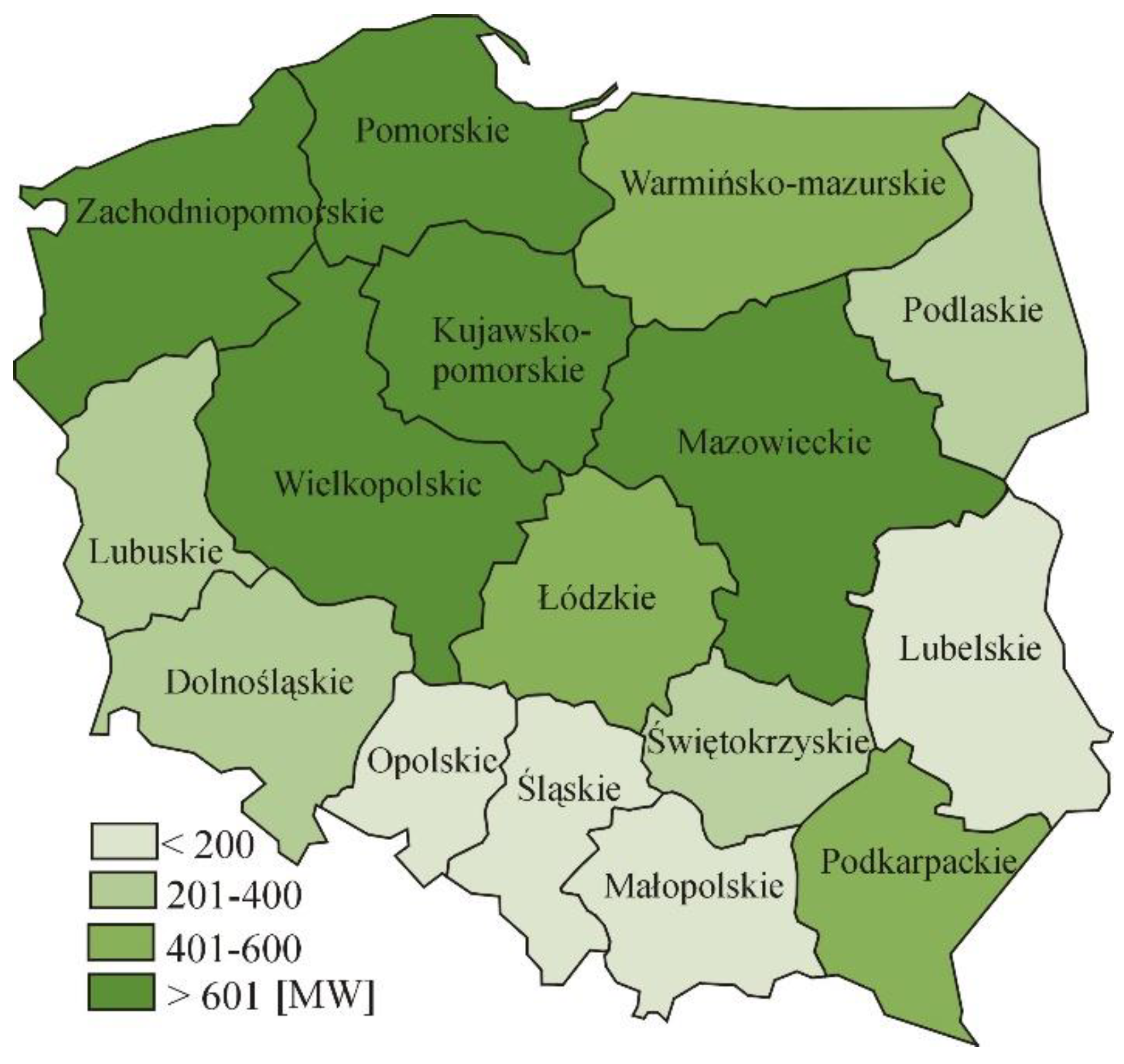
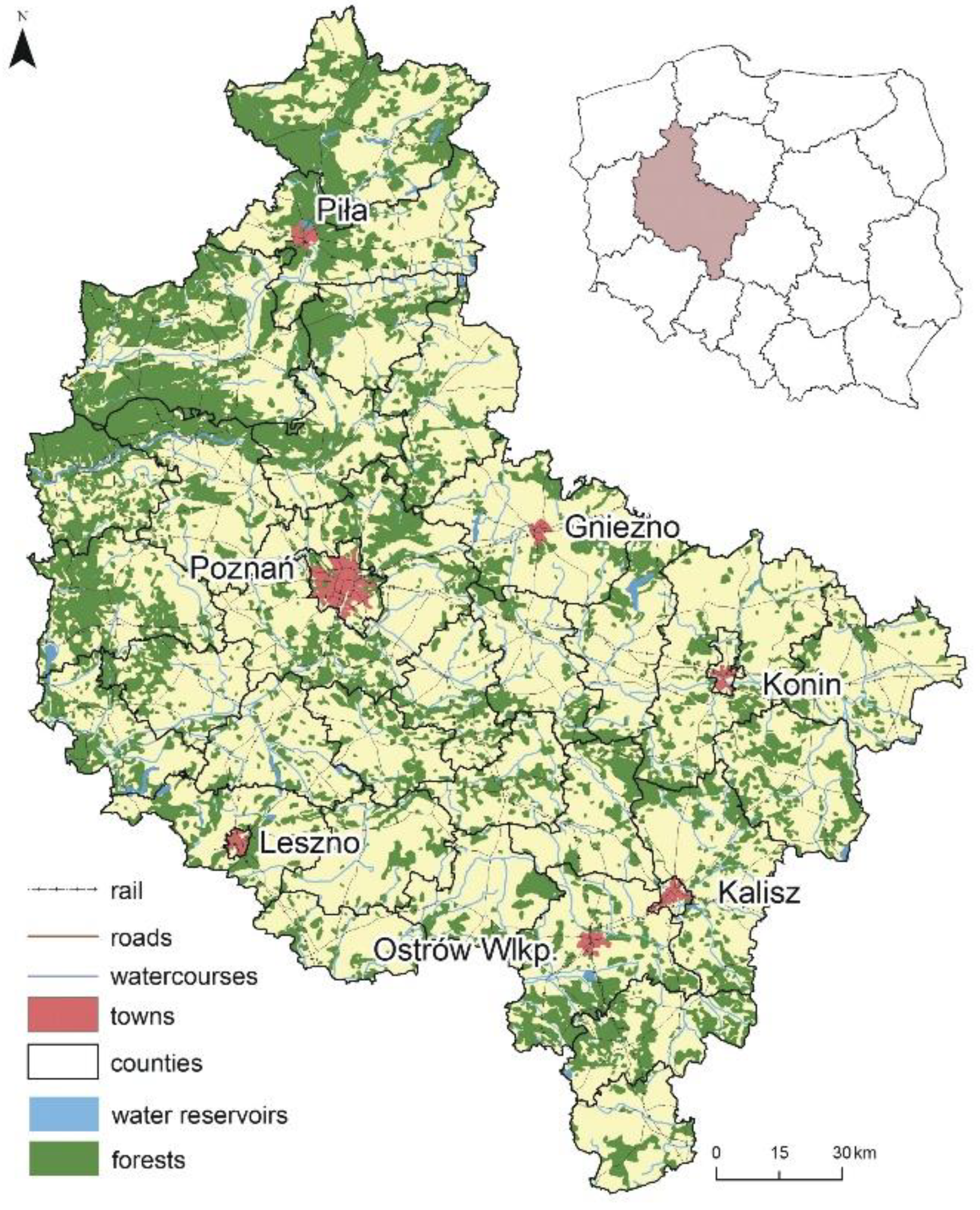
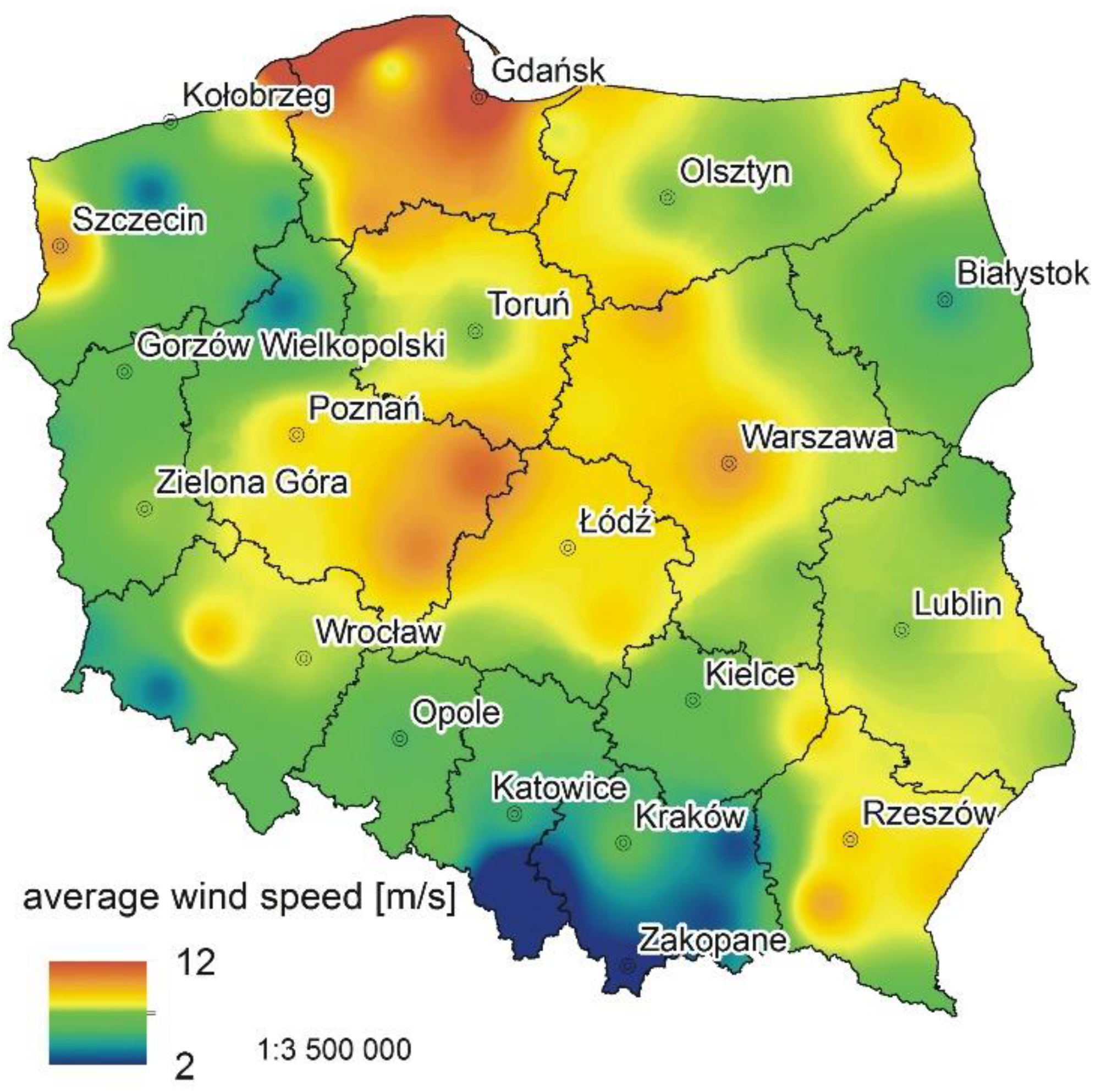
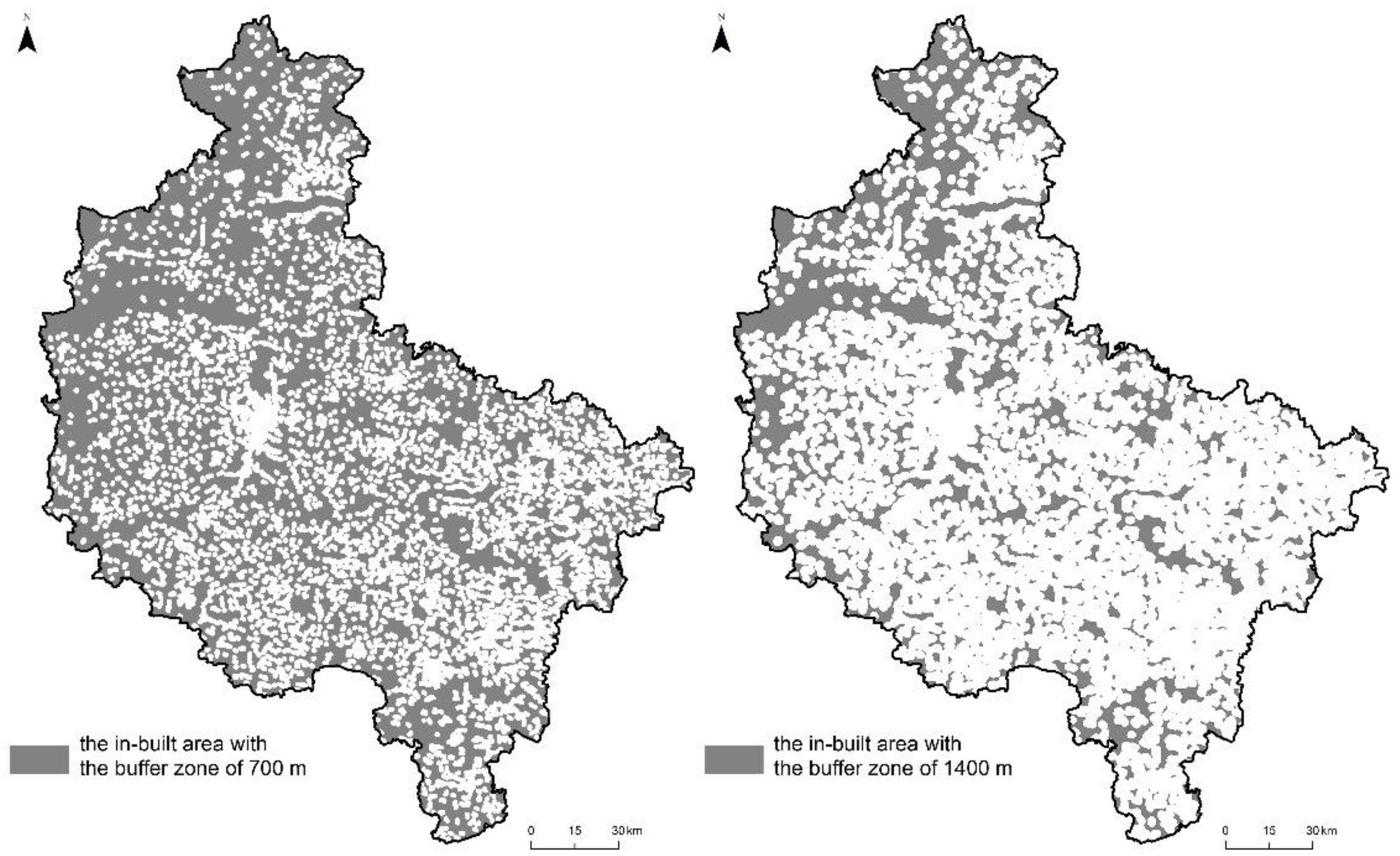
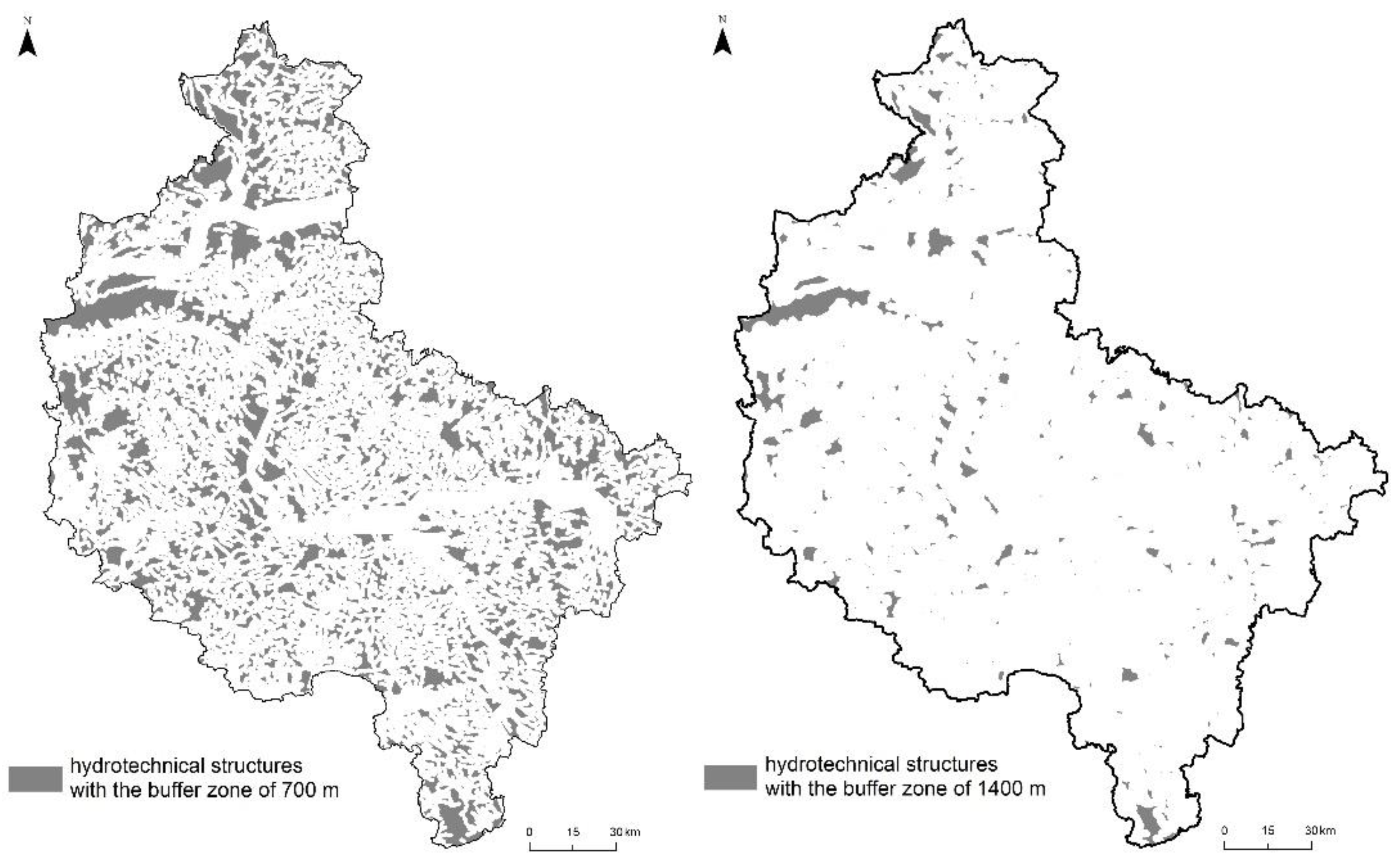
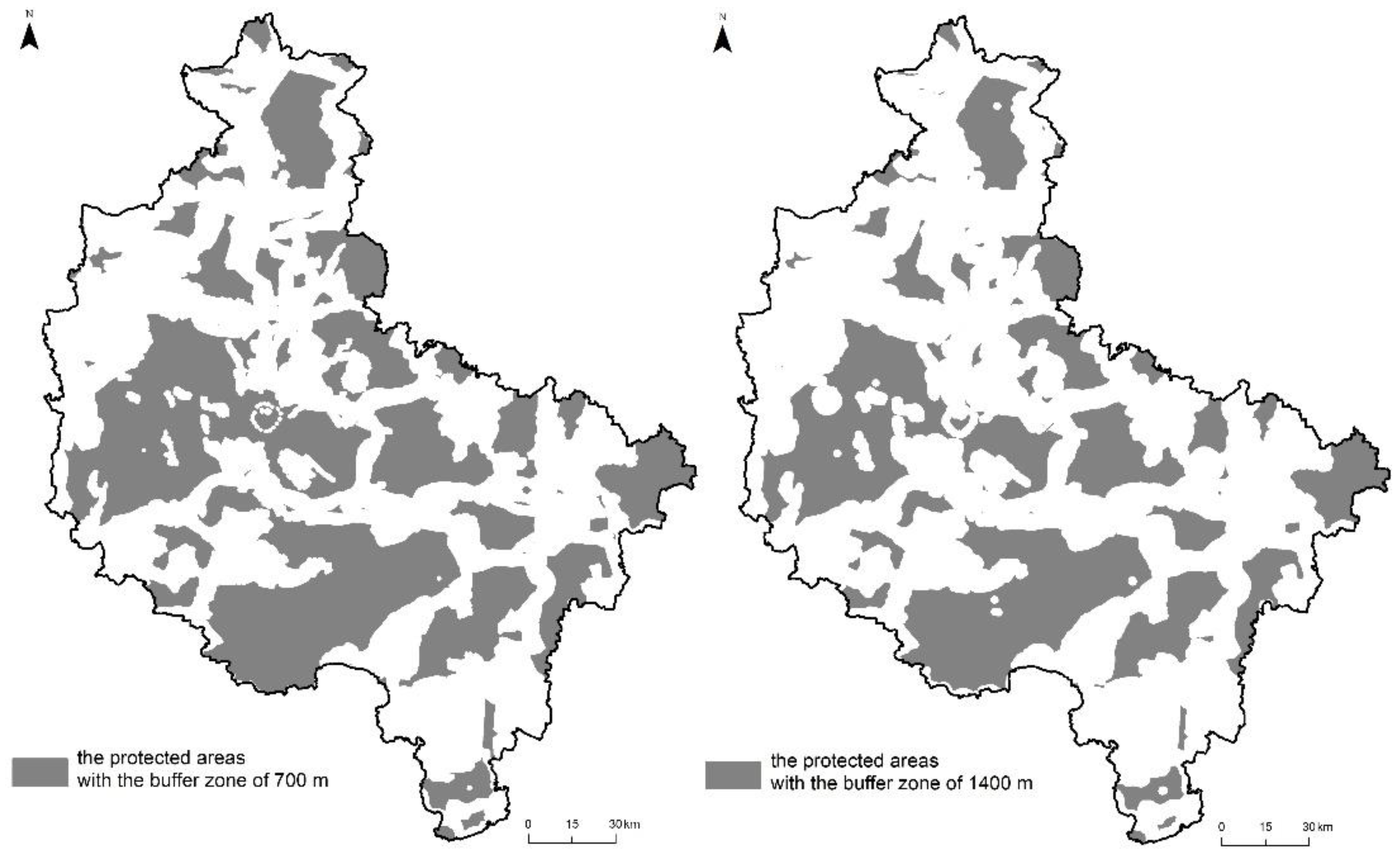
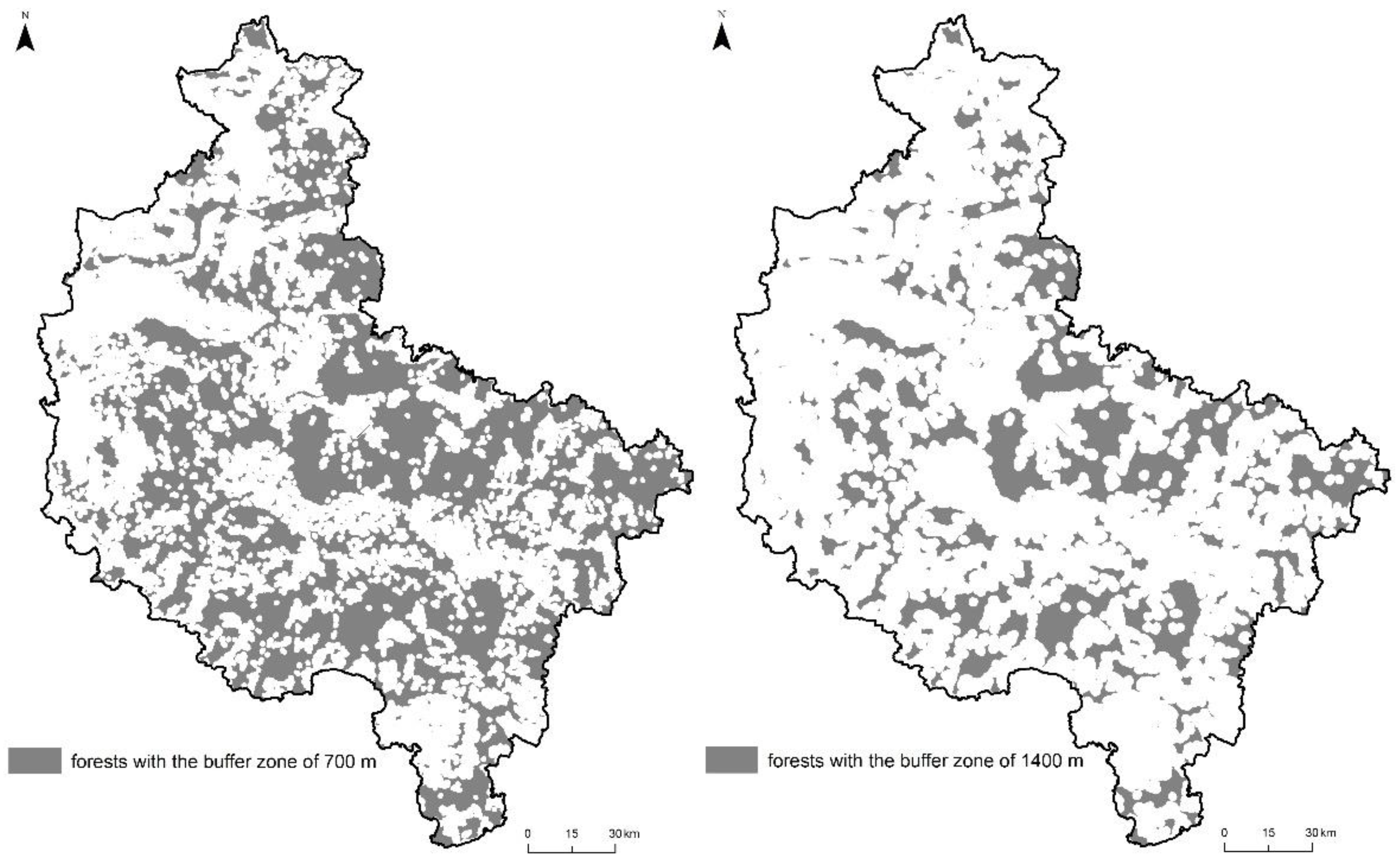
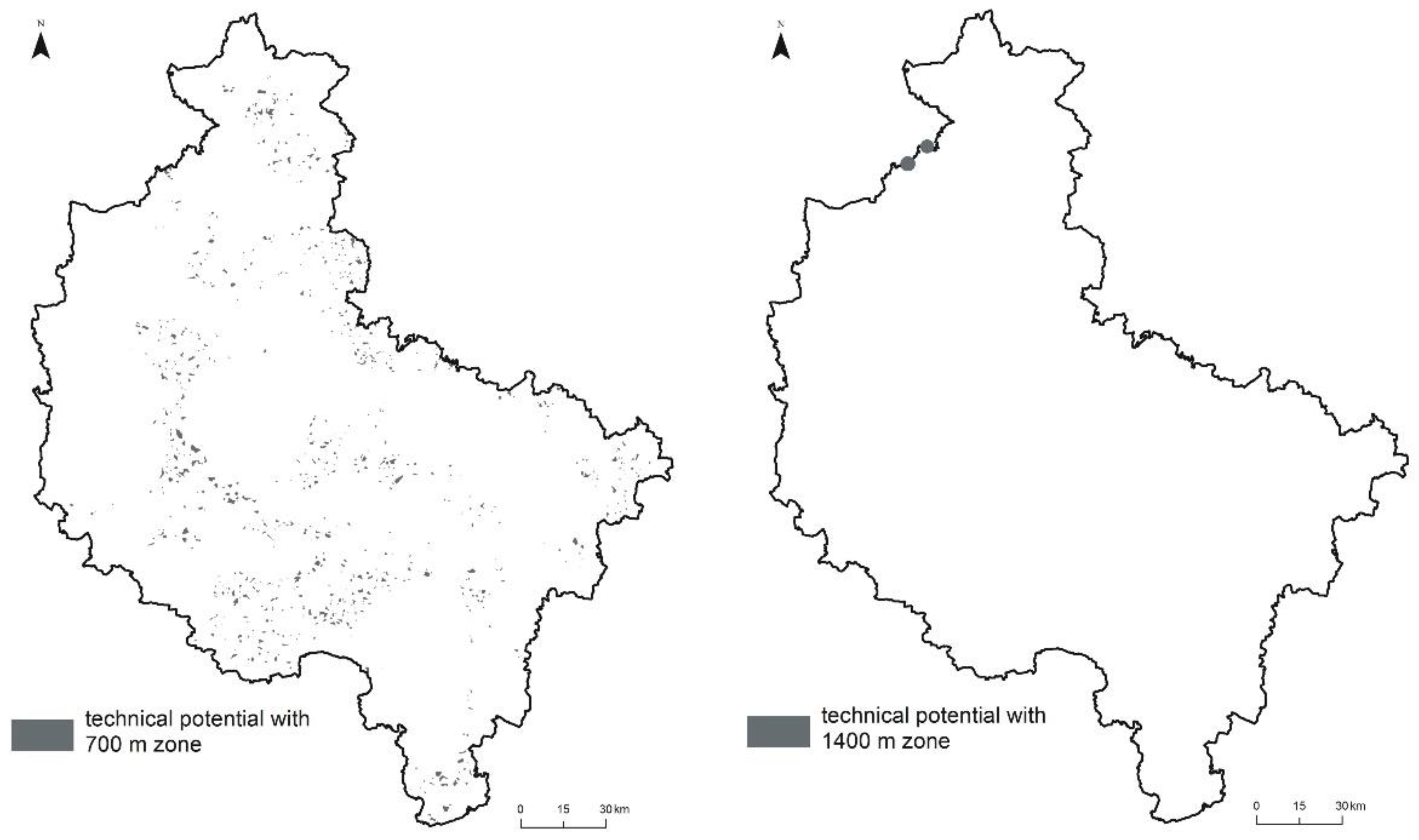
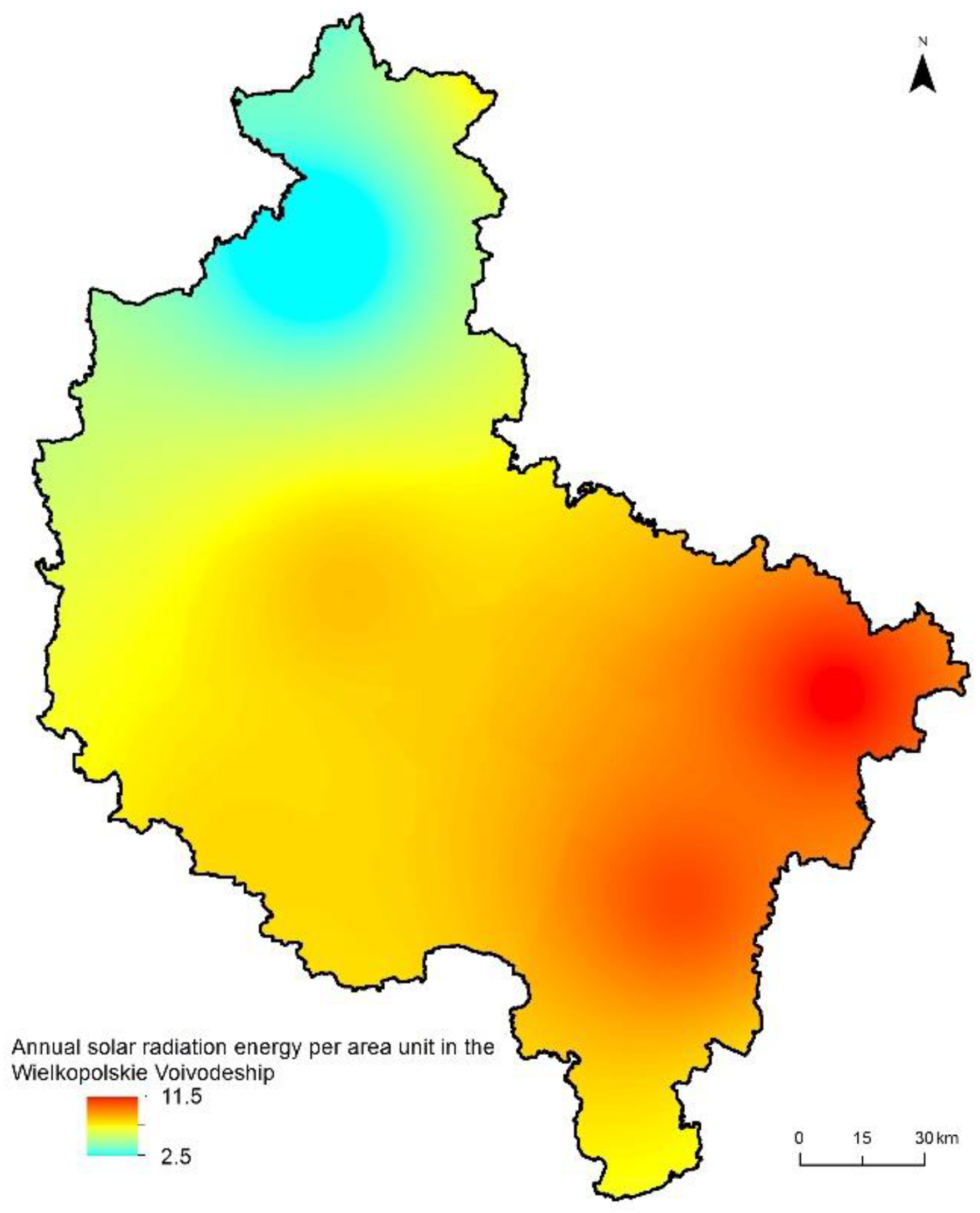
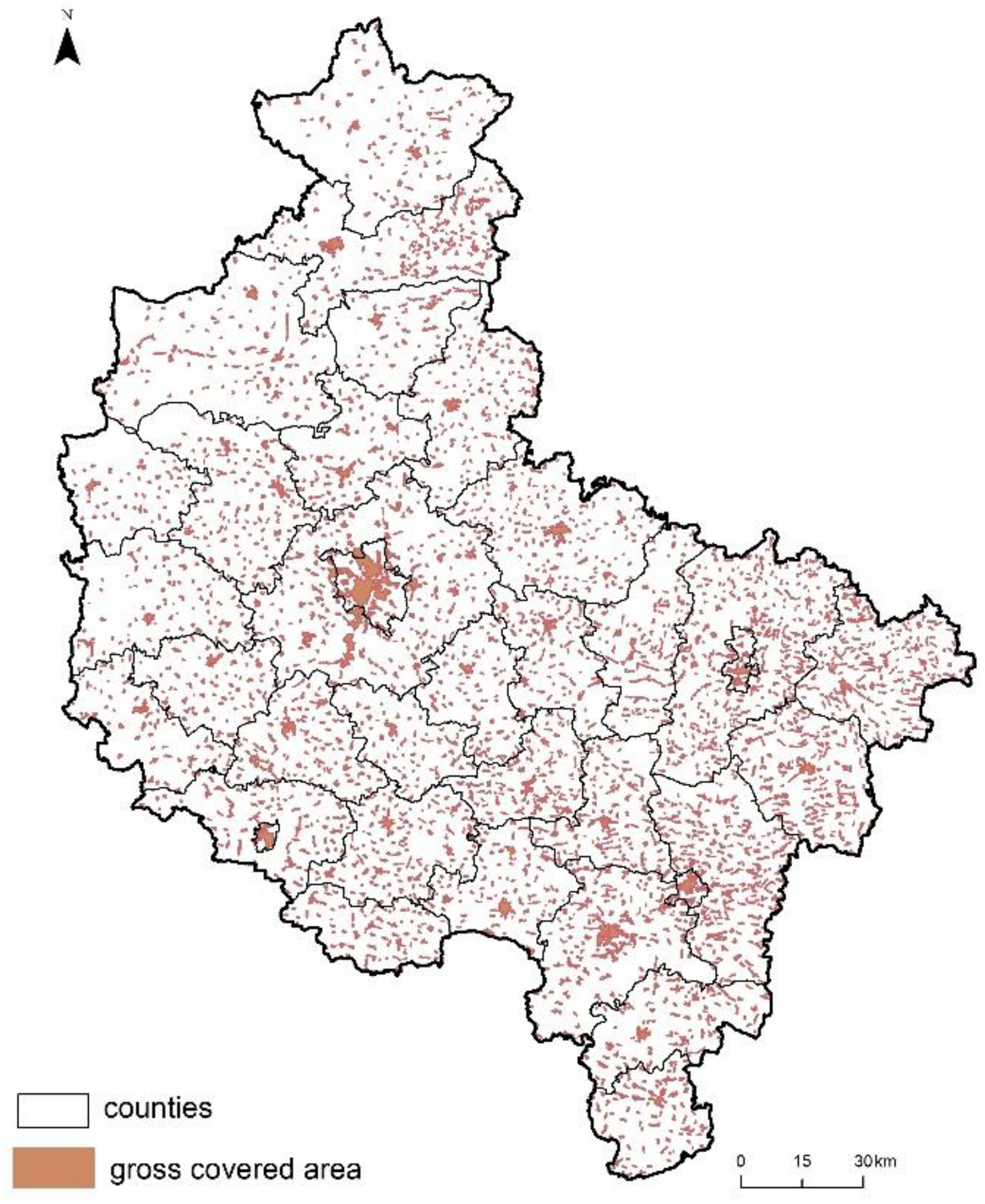
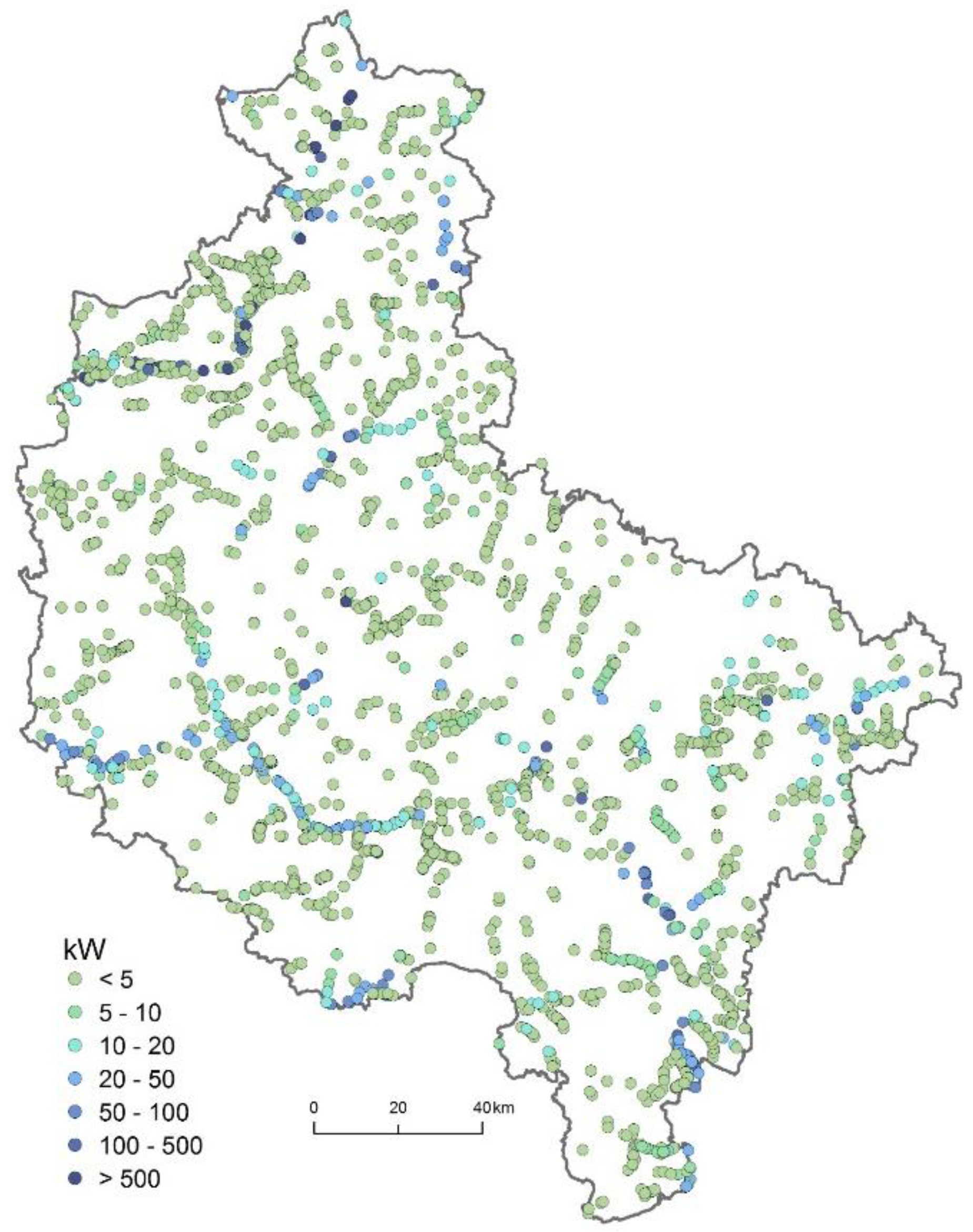
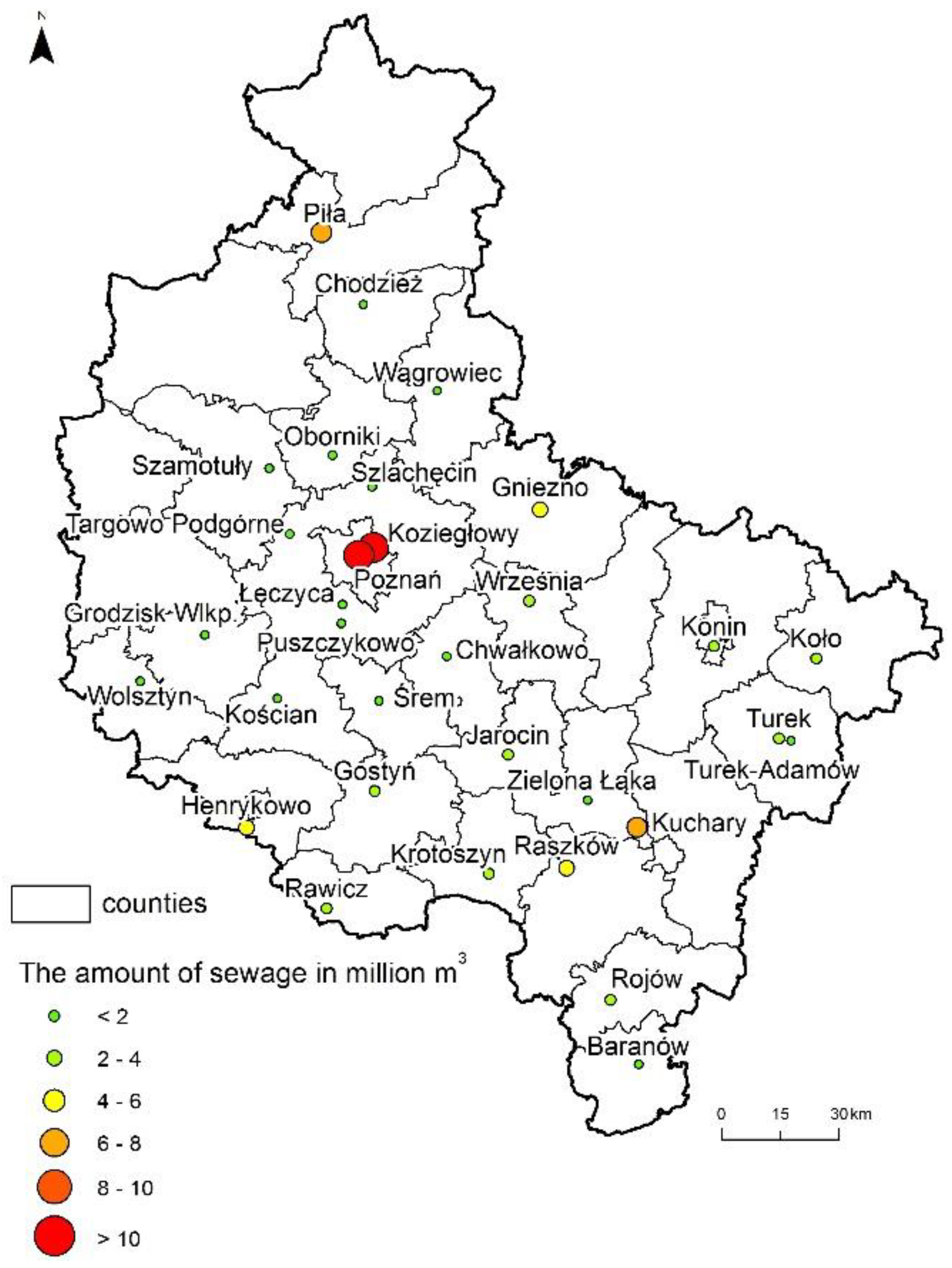
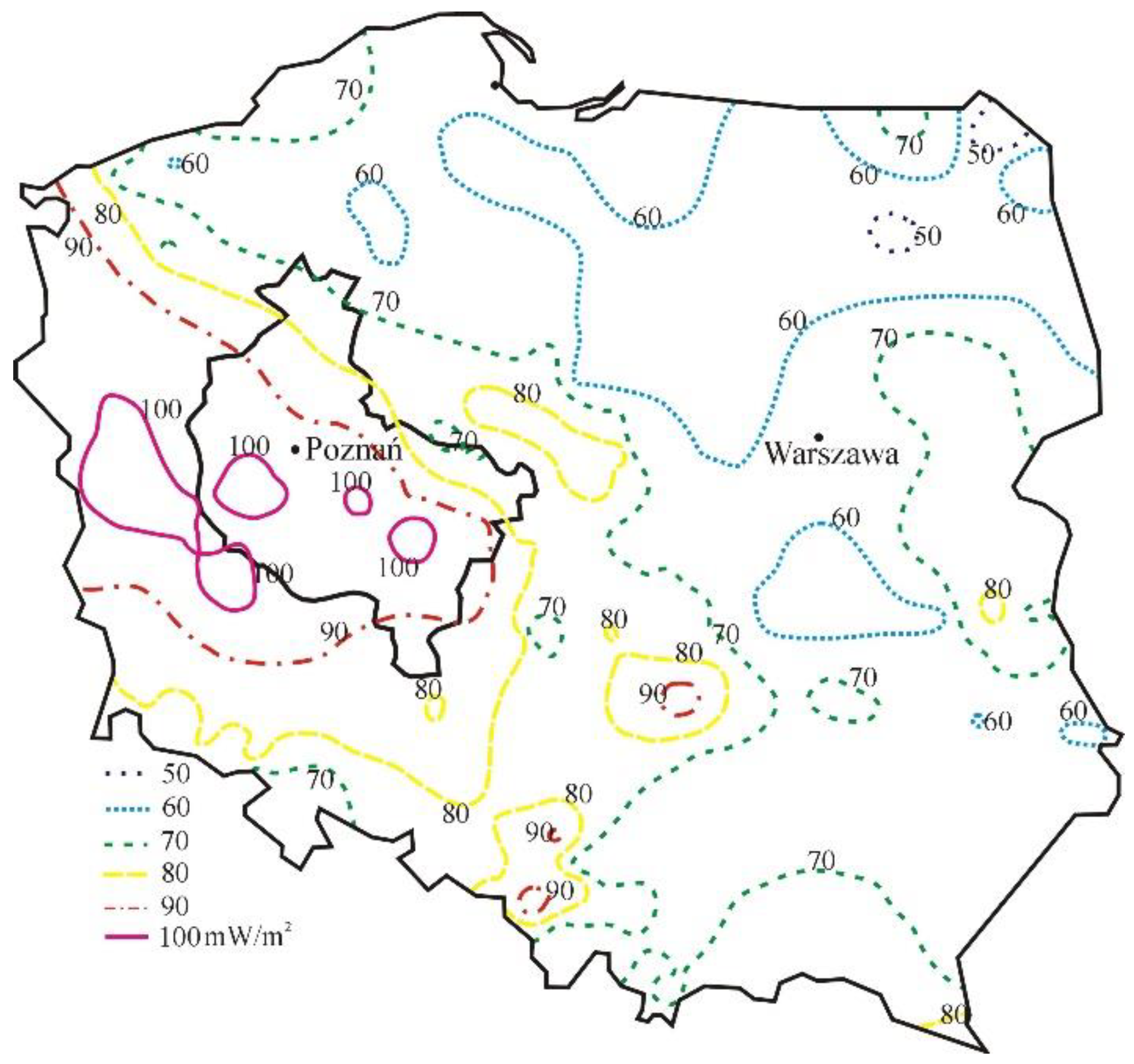
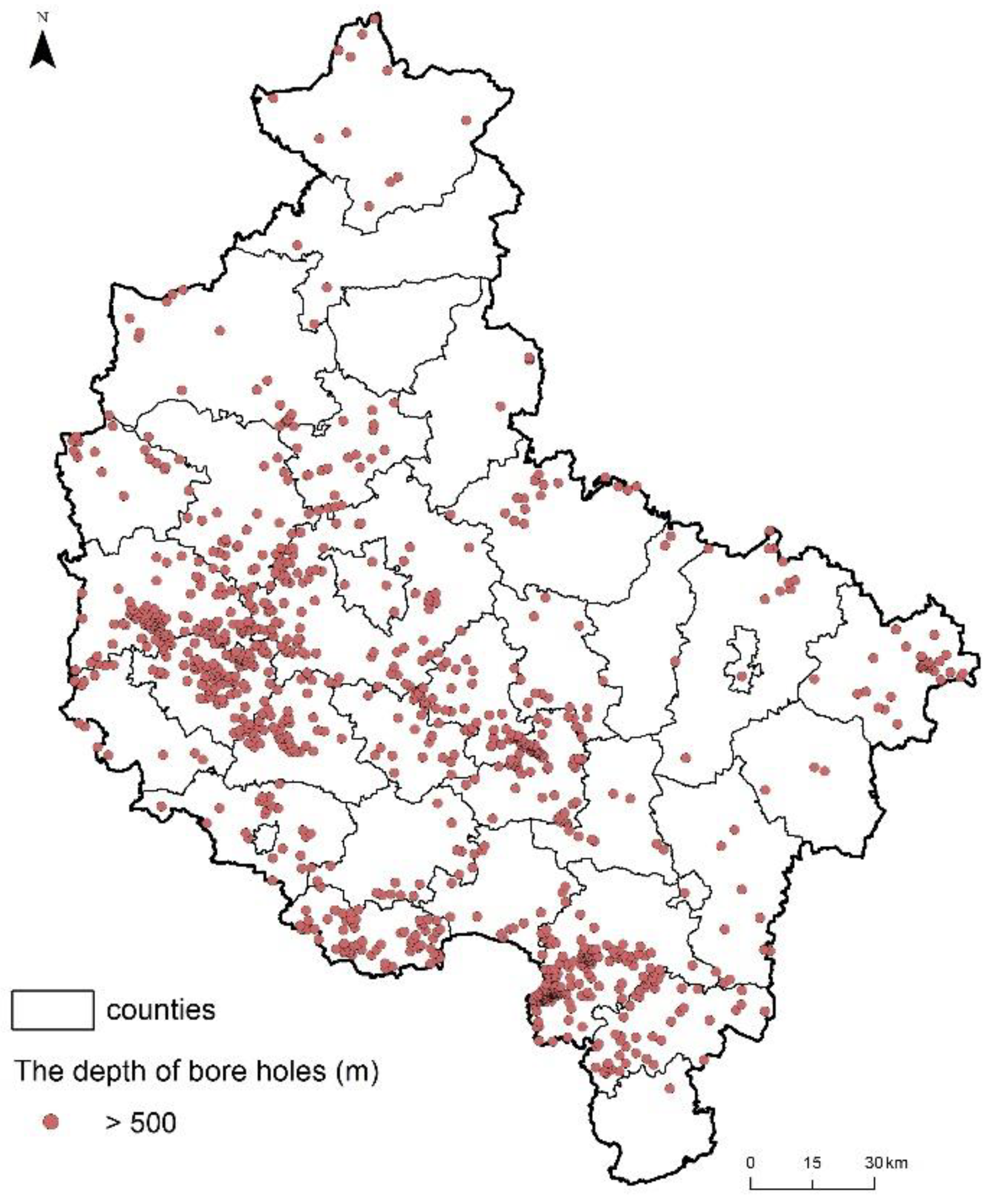
| Biomass (Thousand tons) | Calorific Value (MJ/kg) | Amount of Energy (80% Efficiency) (PJ) | Amount of Electric Power (30% Efficiency) (GWh) | Amount of Heat (50% Efficiency) (PJ) | |
|---|---|---|---|---|---|
| Wooden waste | 540 | 14 | 6.0 | 667 | 3.0 |
| Waste from orchards | 125 | 16 | 1.6 | 178 | 0.8 |
| Straw | 492 | 15 | 5.9 | 656 | 3.0 |
| Hay | 367 | 15 | 4.5 | 496 | 2.2 |
| Energy crops | 510 | 18.5 | 7.6 | 840 | 3.8 |
| Total | 25.6 | 2837 | 12.8 |
| Source of Biogas | Biogas (Million m3) | CH4 Content (%) | CH4 Volume (Million m3) | Amount of Energy (85% Efficiency) (TJ) | Amount of Electric Power (40% Efficiency) (GWh) | Amount of Heat (45% Efficiency) (TJ) |
|---|---|---|---|---|---|---|
| Agriculture (manure, maize straw) | 1.3 | 60 | 780 | 23.7 | 3.1 | 12.5 |
| Municipal waste | 10 | 50 | 5.0 | 152 | 20 | 80 |
| Sewage sludge | 1.6 | 55 | 0.9 | 27 | 4 | 14 |
| Total | 786 | 23.8 | 3.1 | 12.6 |
| Locality | Depth of the Production Bore Hole (m) | Water Temperature at the Outlet (°C) | Total Thermal Power (MW) | Net Amount of Generated Heat (TJ/Year) | Total Electric Power (MW) | Net Amount of Generated Electric Power (GWh/Year) |
|---|---|---|---|---|---|---|
| Koło | 4000 | 118 | 28.3 | 64.7 | 1.05 | 3.16 |
| Turek | 3550 | 98 | 2.45 | 0.25 | 0.45 | 1.70 |
| Konin | 2897 | 98 | 3.23 | 0.35 | 0.43 | 1.15 |
| Ślesin | 3358 | 98 | 0.30 | 0.35 | 0.45 | 2.54 |
| Total | - | - | - | 65.65 | - | 8.55 |
| RES | Amount of Electric Power (TWh) | Amount of Heat (PJ) |
|---|---|---|
| Wind Energy | 8.50 | |
| Solar Energy | 9.84 | 21.45 |
| Bioenergy | 5.99 | 25.40 |
| Hydropower | 0.63 | |
| Geothermal Energy | 0.01 | 0.01 |
| Total | 23.34 | 46.86 |
| Demand in the Voivodeship | 12.48 | 27.89 |
| Oversupply of energy (ratio) | 1.87 | 1.68 |
Publisher’s Note: MDPI stays neutral with regard to jurisdictional claims in published maps and institutional affiliations. |
© 2022 by the authors. Licensee MDPI, Basel, Switzerland. This article is an open access article distributed under the terms and conditions of the Creative Commons Attribution (CC BY) license (https://creativecommons.org/licenses/by/4.0/).
Share and Cite
Igliński, B.; Pietrzak, M.B.; Kiełkowska, U.; Skrzatek, M.; Gajdos, A.; Zyadin, A.; Natarajan, K. How to Meet the Green Deal Objectives—Is It Possible to Obtain 100% RES at the Regional Level in the EU? Energies 2022, 15, 2296. https://doi.org/10.3390/en15062296
Igliński B, Pietrzak MB, Kiełkowska U, Skrzatek M, Gajdos A, Zyadin A, Natarajan K. How to Meet the Green Deal Objectives—Is It Possible to Obtain 100% RES at the Regional Level in the EU? Energies. 2022; 15(6):2296. https://doi.org/10.3390/en15062296
Chicago/Turabian StyleIgliński, Bartłomiej, Michał Bernard Pietrzak, Urszula Kiełkowska, Mateusz Skrzatek, Artur Gajdos, Anas Zyadin, and Karthikeyan Natarajan. 2022. "How to Meet the Green Deal Objectives—Is It Possible to Obtain 100% RES at the Regional Level in the EU?" Energies 15, no. 6: 2296. https://doi.org/10.3390/en15062296
APA StyleIgliński, B., Pietrzak, M. B., Kiełkowska, U., Skrzatek, M., Gajdos, A., Zyadin, A., & Natarajan, K. (2022). How to Meet the Green Deal Objectives—Is It Possible to Obtain 100% RES at the Regional Level in the EU? Energies, 15(6), 2296. https://doi.org/10.3390/en15062296








